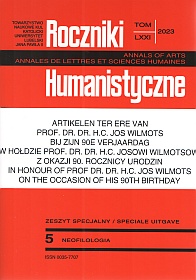Samenstellingen in het Nederlands en Pools – een vergelijkende analyse en enige suggesties voor het taalonderricht
Compounds in Dutch and Polish: A Comparative Analysis and Some Suggestions for Language Teaching
Author(s): Camiel Hamans, Robert de LouwSubject(s): Language and Literature Studies, Foreign languages learning, Theoretical Linguistics, Comparative Linguistics
Published by: Towarzystwo Naukowe KUL & Katolicki Uniwersytet Lubelski Jana Pawła II
Keywords: (nominal) compounds; right-headedness; stress pattern; linking elements; foreign language learning; contrastive linguistics; Dutch; Polish; focus on similarities
Summary/Abstract: In this contribution, Polish and Dutch nominal compounds are compared. The focus is on the similarities between the two phenomena and these similarities are broadly described to aid in the learning of Dutch by Polish-speaking students. This approach has been chosen, since stressing similarities instead of differences offers a better didactic starting point. For Dutch, the difference between a group of words and a compound is first examined on the basis of the literature. Next, the characteristic properties of nominal compounds are described. The emphasis here is on semantic and formal right-headedness, on the stress pattern of compounds and on possible linking elements. Subsequently, again, based on the existing literature, comparable Polish compounds are analysed and described. Finally, it is established that the characteristic properties of Dutch and Polish nominal compounds, however much they differ in frequency, coincide almost completely. The last section of this article explains why it makes more sense to start with similarities than with differences when teaching about compounds.
Journal: Roczniki Humanistyczne
- Issue Year: 71/2023
- Issue No: 5S
- Page Range: 83-103
- Page Count: 21
- Language: Dutch

